12 Diy Ways To Grow A Vertical Strawberry Garden
Growing your own strawberries can be a delightful experience, but it often seems like a daunting task, especially when you’re short on space. However, with vertical gardening, you can turn even the smallest patch of ground or balcony wall into a thriving strawberry haven. This innovative method not only saves space but also reduces the plant’s exposure to soil-borne diseases and pests, making your gardening experience more rewarding.
Imagine being able to pick fresh strawberries at arm’s reach, without having to bend or kneel – it’s a game-changer for those with limited mobility or back issues. Plus, the sight of bright red strawberries suspended in the air can be a delightful addition to any outdoor space. This article will guide you through the process of setting up your own vertical strawberry garden, covering everything from the basics of strawberry plant care to selecting the right vertical structure for your space.
By the end of this read, you’ll have all the knowledge you need to start your vertical strawberry garden and enjoy the fruits of your labor. We’ll explore the different methods for growing strawberries vertically, including hanging baskets, wall-mounted planters, tower gardens, pallet planters, and more. You’ll also learn how to prepare your garden, plant and care for your strawberries, and troubleshoot common issues that may arise.
In addition, we’ll discuss tips for encouraging fruiting, pruning and maintenance for plant health, and seasonal care for year-round production. Whether you’re a seasoned gardener or just starting out, this article will provide you with the tools and inspiration you need to create your own thriving vertical strawberry garden.
Understanding Strawberry Plant Basics
A. Strawberry Plant Characteristics
Strawberries are more than just a sweet treat – their growth habits are also fascinating. At the center of each plant lies a crown that gives rise to leaves, flowers, and roots. This remarkable structure can produce stolons or runners, which can be used to propagate new plants in your vertical garden. As perennials, strawberries have the potential to produce fruit for several years with proper care.
While they typically reach their peak production within the first two to three years, it’s essential to plan ahead and replace plants as needed to maintain a bountiful harvest.
B. Preferred Growing Conditions for Strawberries
Strawberry berries are well-suited for vertical gardening due to their manageable requirements. To thrive, they need conditions that can be easily replicated in an upward setup. Here’s a concise overview of the essential needs: • Sunlight: At least 6 hours of direct sunlight daily. • Soil pH: Slightly acidic with a range of pH 5.5 to 6.8. • Temperature: A temperate range of 60°F to 80°F is ideal.
Adequate drainage is vital to prevent root rot, and the natural air circulation in a vertical garden can aid in minimizing fungal diseases that often afflict strawberry plants.
C. Importance of Choosing the Right Strawberry Variety
When it comes to building a thriving vertical garden, selecting the ideal strawberry variety is crucial. There are three primary types: June-bearing, everbearing, and day-neutral. June-bearing varieties produce a single, large crop each year over a period of 2-3 weeks, making them suitable for preserving or enjoying in bulk. Everbearing plants offer multiple smaller harvests throughout the growing season, ideal for fresh eating.
Day-neutral varieties can provide continuous fruit production throughout the season. When choosing a variety, consider your local climate and available space. Some strawberry types perform better in cooler temperatures, while others thrive in warmer conditions.
To simplify the decision-making process, here’s a helpful guide:For June-bearing: large harvests, preservingFor everbearing: extended harvests, fresh eatingFor day-neutral: continuous supply, small spacesKeep in mind that the right variety will ensure you get the best flavor and most berries from your vertical garden. Look for varieties known to excel in container or vertical gardens, as they are better suited to handle the unique growing conditions of up-growing rather than out-growing.
Choosing the Right Vertical Gardening Method
Growing strawberries vertically requires careful consideration of the best approach. While several methods exist, each offers unique benefits that can impact the outcome. Let’s explore some of the most popular options and what they have to offer.
A. Hanging Baskets
For those with limited outdoor space, hanging baskets offer an ideal solution for vertical gardening. Perfect for apartment dwellers with small balconies or patios, these baskets provide a compact and straightforward way to grow a variety of plants. One of the most creative ways to utilize hanging baskets is by suspending them at varying heights to create a lush ‘living wall’ filled with juicy strawberries.
However, it’s essential to note that these baskets require more frequent watering than traditional gardens, as the soil can dry out quickly due to their elevated position.
B. Wall-Mounted Planters
Transforming a bare wall into a thriving oasis is just a few screws away with wall-mounted planters. Not only do they effectively utilize floor space, but they can also serve as a striking design element in their own right. The versatility of these planters is truly impressive, available in a range of sizes and accommodating diverse arrangements to suit your unique taste and spatial constraints.
Moreover, many wall-mounted planters feature built-in watering systems, simplifying the upkeep process and making them an attractive option for busy green thumbs.
C. Tower Gardens
Tower gardens ingeniously maximize vertical space by allowing plants to thrive in upward-facing columns. This innovative approach can be achieved through either soil-based or hydroponic methods. One notable advantage of tower gardening is its suitability for strawberry cultivation, where it provides ample room for the plants to spread out without occupying valuable ground area. Moreover, this design simplifies harvesting significantly, as the fruit is readily accessible and easy to collect.
D. Pallet Planters
Transforming wooden pallets into garden planters offers a unique blend of eco-friendliness and aesthetic appeal. These upcycled containers can be cleverly angled against a wall or placed independently, injecting a touch of rustic charm into your outdoor space. What’s more, the slatted design of pallets lends itself perfectly to cultivating strawberries, guaranteeing each plant receives the optimal balance of light and air.
E. Comparison of Different Methods
When it comes to vertical strawberry gardening, each method has its own set of advantages and disadvantages. To help you make an informed decision, let’s weigh the pros and cons of popular methods:
Hanging baskets offer portability, decorative flair, and are suitable for small spaces, but they require frequent watering and have limited growth space.
Wall-mounted planters provide a space-saving solution that can be aesthetically pleasing, but installation is required and may be costly.
Tower gardens boast high yields, easy harvesting, and can be soil-based or hydroponic, yet initial setup can be complex and may demand more maintenance.
Pallet planters are eco-friendly, cost-effective, and offer a rustic look, although they might require lining or modification and have limited space per plant.
When choosing the best method for your vertical strawberry garden, consider factors like available space, budget, time commitment for maintenance, and personal preference.
While each method can produce delicious strawberries with proper care, selecting the one that aligns with your gardening style will ensure a bountiful harvest and satisfaction.
Preparing Your Vertical Strawberry Garden
To set the stage for a thriving strawberry harvest, it’s essential to meticulously prepare your vertical garden before planting. This involves identifying an optimal location, amending the soil to ensure its optimal pH and nutrient levels, strategizing plant placement and spacing, and implementing a reliable irrigation system to guarantee consistent moisture.
A. Selecting the Right Location
When selecting an ideal location for your strawberry patch, consider a spot that receives direct sunlight for at least six to eight hours daily. This will provide the necessary warmth and light required by the plants. Additionally, ensure the area is sheltered from strong winds, which can cause drying or damage to the plants and potentially topple your vertical setup. Moreover, prioritize a location that offers easy accessibility for effortless harvesting and maintenance purposes.
B. Soil and Compost Preparation
The success of any strawberry garden lies in its foundation: the quality of the soil. For optimal growth, strawberries require a rich, well-draining, and slightly acidic environment (pH ranging from 5.5 to 6.8). To create the ideal growing conditions, mix equal parts of garden soil, compost, and peat moss to enhance fertility and moisture retention.
Furthermore, when using containers or planters, ensure they have sufficient drainage holes to prevent waterlogging and promote healthy root development.
C. Planting and Spacing Considerations
In vertical gardening, strawberry placement is crucial for optimal growth and disease prevention. Each plant requires sufficient space to unfurl and access necessary sunlight and air circulation. A general guideline for spacing strawberry plants is 8-12 inches apart, allowing them to spread without competing excessively for resources. When utilizing pallets or wall planters, it’s recommended to allocate one strawberry per opening or slot.
In tower gardens, adhere to the system’s specified spacing guidelines to ensure a healthy and thriving strawberry crop.
D. Watering System Setup
In order to thrive, strawberries require consistent moisture. However, overwatering can lead to root rot and other issues. To overcome this challenge in vertical gardens, a drip irrigation system is an excellent solution. This type of system directly supplies water to the roots, allowing for precise control and customization according to your plants’ needs. For hanging baskets and other containers, consider implementing a self-watering system or adopting a regular hand-watering routine.
Alternatively, if you’re frequently away from home, investing in an automated watering system can provide peace of mind, knowing that your plants are receiving the necessary hydration.
Planting and Caring for Your Strawberries
To ensure a thriving and bountiful harvest from your vertical strawberry garden, it’s crucial to plant and maintain it correctly. Following a structured approach and adopting key care practices will help your plants flourish. Here’s a detailed walkthrough of the planting process and some valuable advice to keep in mind as you nurture your strawberries.
A. Step-by-Step Guide to Planting Strawberry Runners or Seedlings
When it comes to growing healthy strawberry plants, the key is to start with strong and robust seedlings or runners. Look for plants with vibrant green leaves and well-developed root systems, as these will have a head start on producing fruit. Before planting, prepare your soil mix by combining potting soil with compost to create a nutrient-rich environment that will support your plants’ growth.
When you’re ready to plant, dig a hole large enough to accommodate the roots of each strawberry without bending them. Place the crown of each plant – where the roots meet the stems – just above the surface of the soil. This is crucial for preventing rot and ensuring healthy growth. Once your plants are in place, gently firm the soil around their roots to eliminate any air pockets that may have formed during planting.
Finally, give your newly planted strawberries a good drink of water to help them settle into their new environment and get established.
B. Watering Requirements
To ensure optimal strawberry growth, maintain consistent moisture levels, particularly during the fruiting period. Aim for a soil condition that’s neither too dry nor soggy by watering regularly. In scorching heat, you might need to water twice daily. Monitor your plants’ response – wilting leaves or dry soil are telltale signs it’s time for a drink.
For maximum effectiveness and minimal evaporation, consider early morning watering when the sun is gentle.
This allows the leaves to dry slightly, reducing the risk of fungal diseases.
C. Fertilizing for Healthy Growth
To promote robust growth in your strawberry plants, utilize a well-rounded fertilizer with a balanced NPK ratio (nitrogen, phosphorus, potassium). A 10-10-10 formula is an excellent starting point. Apply this formula every four to six weeks during the growing season to provide sustained nutrition. It’s essential to maintain a delicate balance, as excessive fertilization can result in leafy foliage at the expense of fruit production.
This outcome will leave your plants producing fewer strawberries than they could be.
D. Disease and Pest Control
Maintaining healthy strawberries requires close attention to potential threats from pests and diseases. Regular inspections are crucial to catch any issues early, such as spotting discolored leaves or damaged fruit. Swiftly removing affected parts can prevent the spread of trouble and keep your plants thriving.
For a more natural approach, neem oil can be an effective tool in controlling pesky insects, while ensuring proper spacing and airflow between plants can help minimize the risk of fungal infections taking hold. If persistent problems arise, consider seeking guidance from local gardening experts or extension services to determine the most suitable treatment options for your specific location and situation.
Vertical Strawberry Tube Planter
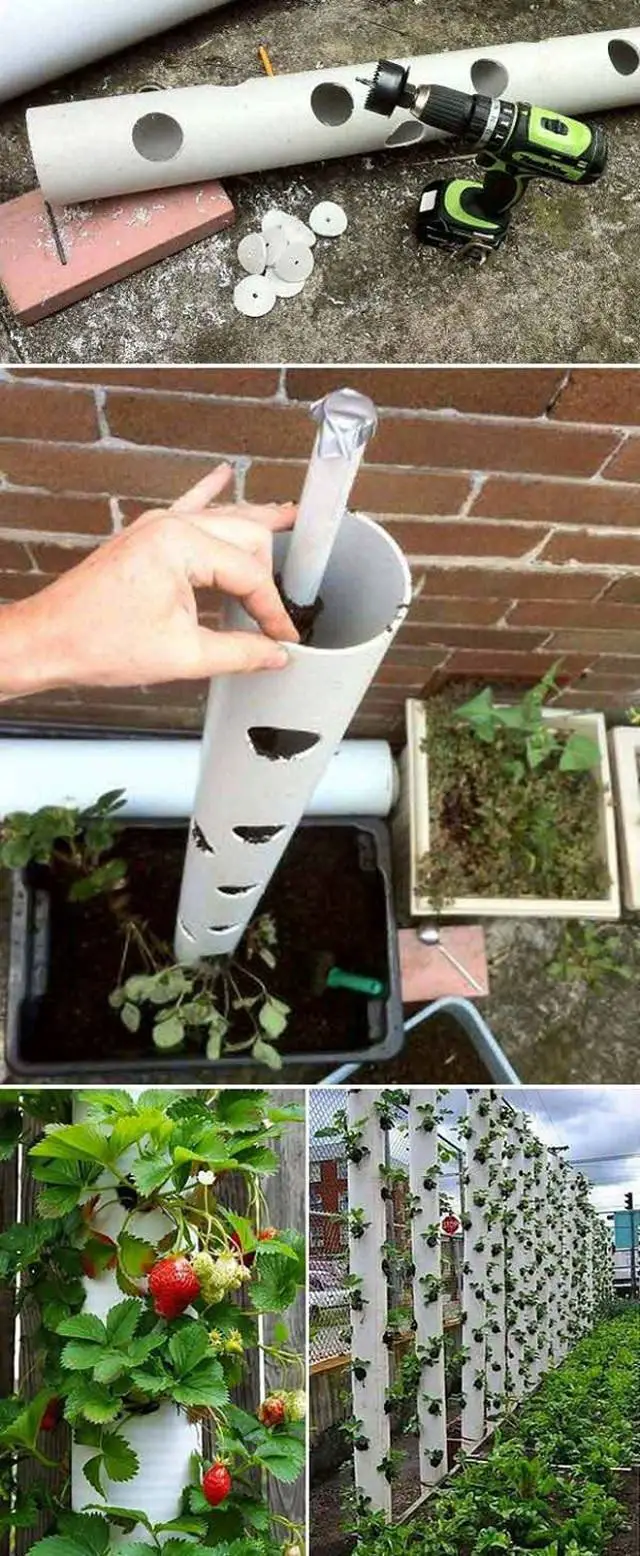
Create your own hanging strawberry planter
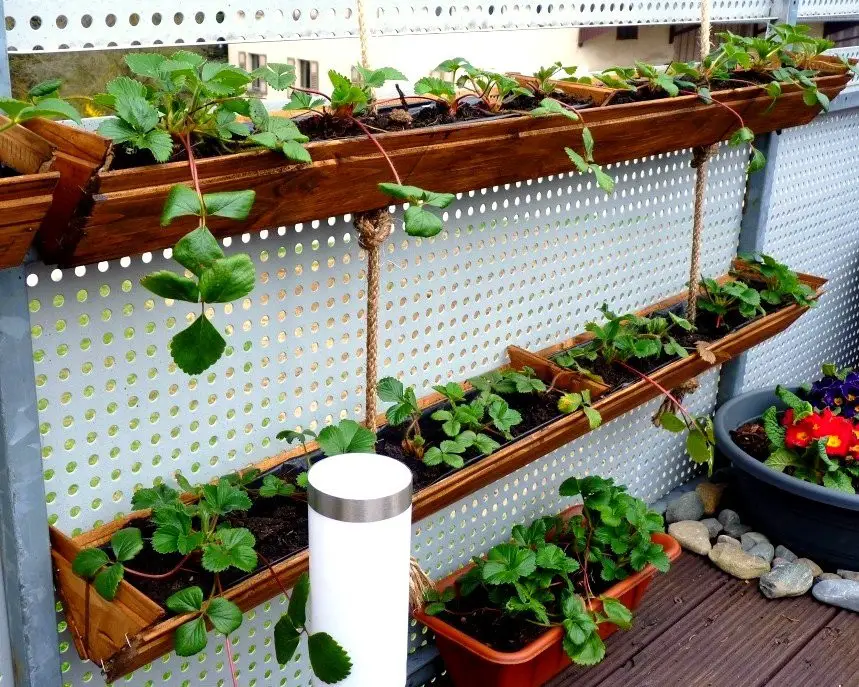
Vertical Pyramid Planter
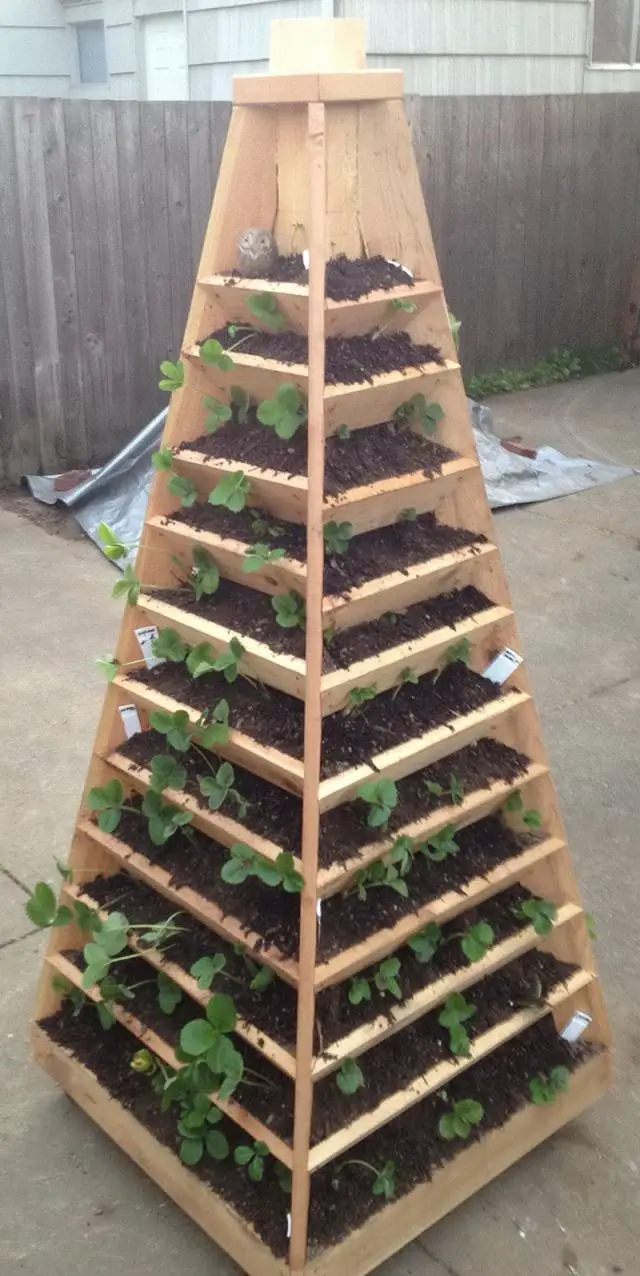
Rain gutters Strawberry Garden
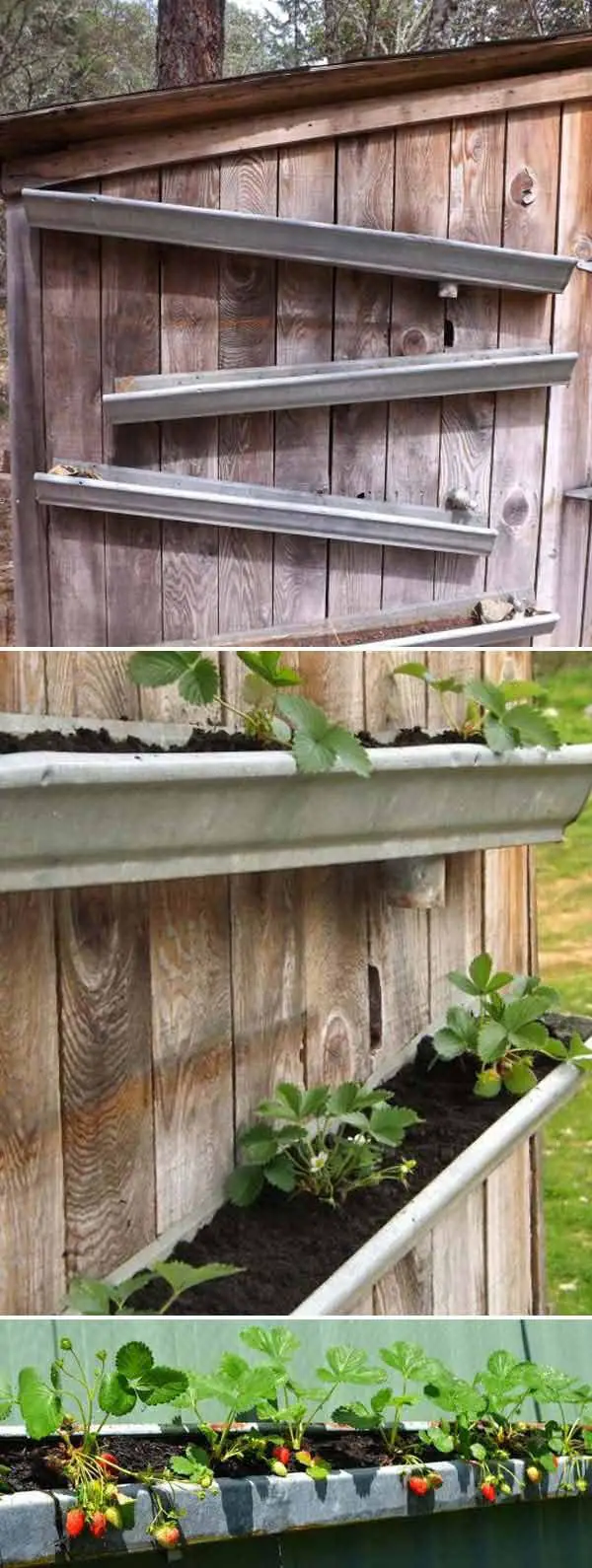
Hanging Basket
Strawberry Tower
Strawberry Pallet Planter
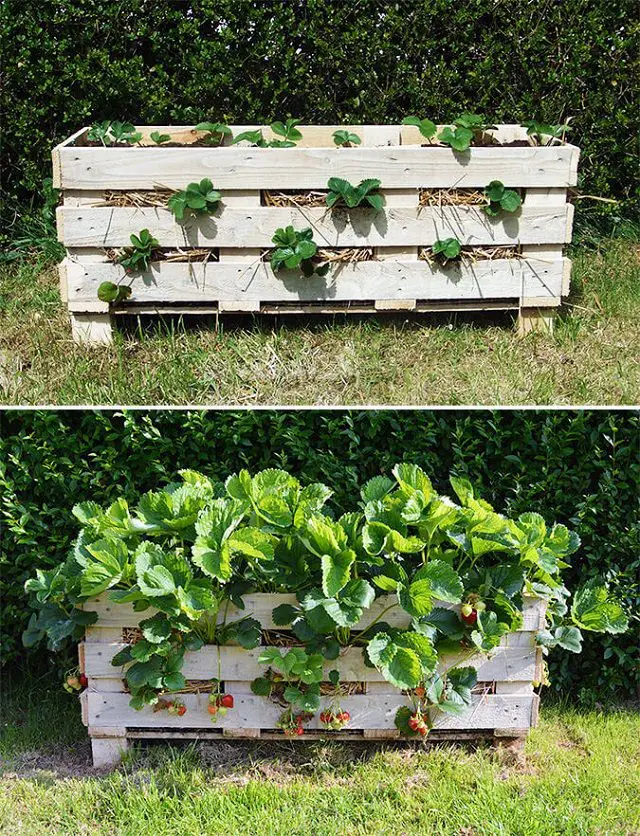
Picket Fence Strawberry Tower
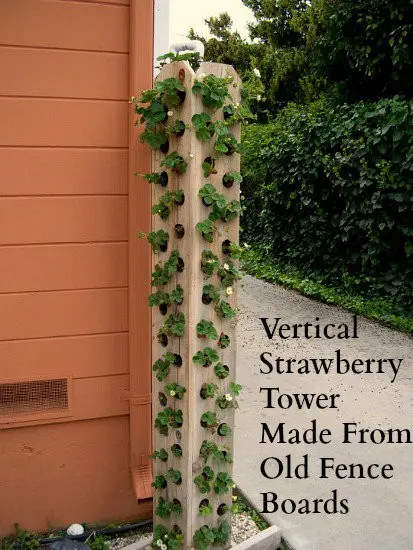
Hanging Strawberry Planters
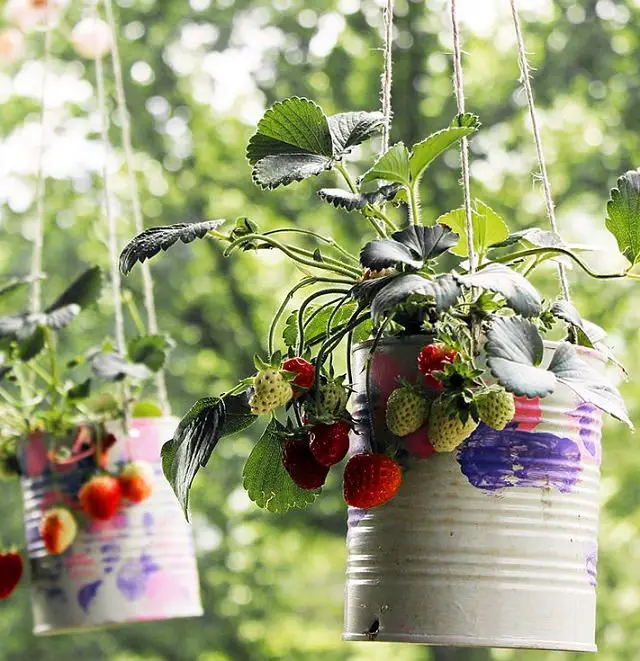
Stepped Strawberry Ladder
Strawberry Gutter Garden

A Strawberry Jar
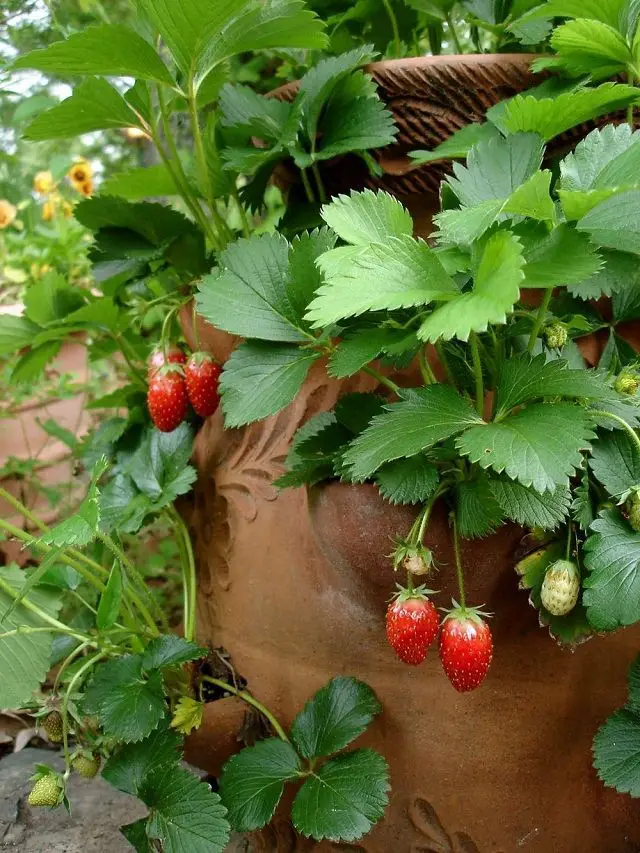
Maximizing Strawberry Production
For a thriving vertical strawberry garden, it’s crucial to prioritize techniques that promote heavy fruiting and overall plant wellness. By adopting these strategies, you’ll be able to enjoy a bountiful harvest while keeping your plants happy and healthy all year round.
A. Tips for Encouraging Fruiting
To optimize strawberry yields, consider these key factors. Firstly, ensure your plants receive full sunlight as this can significantly boost fruit production. Additionally, encourage pollination by attracting bees or manually pollinating flowers – this will increase the chances of successful fruit set. When planting new strawberries, it’s essential to pinch off blossoms for a few weeks, directing energy towards plant growth rather than fruiting.
Furthermore, regulate runner growth to concentrate the plant’s energy on producing more fruit, resulting in healthier and more abundant harvests.
B. Pruning and Maintenance for Plant Health
To maintain a healthy and thriving garden, it’s essential to prioritize leaf removal, pruning, and plant renewal. Start by removing dead or diseased leaves to prevent the spread of disease and pest infestations. This simple step can make a significant difference in your plants’ overall health. Next, tackle areas with overcrowding by thinning out dense foliage, which will improve air circulation and sunlight exposure.
Prune runners to direct your plants’ energy towards fruiting, rather than wasting it on unnecessary growth. Finally, consider renewing older plants that have been in the same spot for over three years, as their fruiting potential naturally declines with time. By implementing these strategies, you’ll be able to keep your garden thriving and productive.
C. Seasonal Care for Year-Round Production
To ensure a thriving strawberry patch, consider these seasonal care tips: Mulching is an effective way to shield roots from harsh winter conditions and conserve moisture during the hot summer months. You can use straw or wood chips to achieve this. When winter temperatures drop in colder climates, safeguard your strawberries with row covers or by relocating containers indoors to prevent damage from freezing temperatures.
Spring brings the opportunity to tidy up any plant debris and fertilize to prime the soil for the growing season. In the summer, prioritize regular watering, fertilization, and harvesting to keep your strawberry plants productive. Finally, after the last harvest in autumn, take the time to prepare your strawberry patch for the winter ahead and plan for next year’s crop, ensuring a bountiful yield.
Troubleshooting Common Issues
Despite meticulous preparation and upkeep, your vertical strawberry garden may still face obstacles. To ensure optimal growth, learn how to effectively troubleshoot and overcome these common hurdles.
A. Addressing Poor Fruit Production
When struggling with subpar strawberry production, it’s essential to consider several key factors. A well-balanced nutrient intake is crucial – excessive nitrogen can lead to leafy foliage at the expense of fruiting, while an imbalance in any other direction may also impact yields. Additionally, maintaining consistent soil moisture levels is vital, as both overwatering and underwatering can negatively affect fruit production.
Furthermore, pollination issues can be a significant hindrance, so ensuring adequate pollinator activity or attempting hand-pollination techniques may be necessary to encourage fruit set. Finally, the age of your strawberry plants should also be taken into account – those that are three years old or more tend to produce fewer fruits, making it potentially time to replace them and give your garden a fresh start.
B. Managing Pests and Diseases
To maintain a healthy strawberry harvest, it’s essential to proactively manage potential threats from pests and diseases. Start by establishing a regular inspection routine to detect any issues early on. This involves carefully examining your plants for signs of infestation or infection. By staying vigilant, you’ll be able to catch problems before they escalate. In addition to monitoring, maintaining cleanliness in the surrounding area is crucial.
Remove any debris or decaying matter that may attract pests or foster disease growth. A clean environment reduces the likelihood of disease transmission and makes it easier to identify any potential issues. You can also take advantage of natural predators that prey on common strawberry pests. By creating a welcoming habitat for these beneficial insects, you’ll encourage them to thrive in your garden, helping to keep pest populations under control.
When necessary, consider using organic or recommended fungicides and insecticides as part of an integrated pest management strategy. Always follow the manufacturer’s instructions for application rates and timing to ensure optimal effectiveness while minimizing potential harm to people, pets, and the environment.
C. Dealing with Environmental Stressors
When cultivating strawberries in a vertical setup, environmental factors can significantly impact plant health and productivity. To mitigate these effects, it’s essential to consider temperature extremes, wind, and sun exposure.
Temperature fluctuations can be detrimental to your strawberry plants. Extreme heat or cold can cause stress, making it crucial to provide adequate shade or frost protection using materials like cloths or covers.
Strong winds can also dry out the plants and disrupt pollination processes, necessitating secure vertical structures to withstand gusts.
On the other hand, optimal sun exposure is vital for strawberry health. While too much sunlight can scorch your plants, insufficient light can hinder fruit production. Achieving a balance between these factors will help you overcome common issues and enjoy a thriving vertical strawberry garden.
Beyond Strawberries: Rotating Crops and Companion Planting
While strawberries may be the star attraction of your vertical garden, diversifying with a variety of plants and implementing crop rotation can unlock a wealth of advantages. By doing so, you’ll not only create a visually appealing display, but also reap the rewards of a more resilient and dynamic ecosystem.
A. Benefits of Crop Rotation in a Vertical Garden
Crop rotation is a simple yet effective technique that involves alternating different types of plants in a specific area over time. This approach has numerous benefits, including the ability to prevent soil depletion. By growing different crops, farmers can ensure that the soil remains fertile and nutrient-rich, as each plant type requires varying levels of nutrients. Furthermore, crop rotation can significantly reduce pests and diseases by disrupting their life cycles.
Many pests and diseases are specific to certain plants, so by changing crops regularly, farmers can prevent these unwanted visitors from gaining a foothold. Additionally, different crops can have a positive impact on soil structure and microbial health, ultimately leading to improved plant growth. By incorporating crop rotation into their farming practices, growers can reap these rewards and enjoy healthier, more productive crops.
B. Companion Plants for Strawberries
When it comes to companion planting, certain plants can work together in harmony to create a thriving and healthy garden. Among the most beneficial companions for strawberries are marigolds, borage, thyme, and lettuce.
Marigolds stand out as particularly effective at repelling pests with their pungent scent, making them an excellent choice for strawberry plots. Borage, on the other hand, attracts pollinators while keeping worms at bay, ensuring a healthy and productive strawberry harvest.
Thyme, when planted between strawberry rows, can help deter those pesky worms from wreaking havoc on your plants. And finally, lettuce is a low-maintenance neighbor that doesn’t compete heavily with strawberries for nutrients, making it an ideal companion to have by their side.
C. Planning for Seasonal Changes
To maximize year-round productivity in your vertical garden, it’s essential to adapt your plan to seasonal changes. By doing so, you’ll be able to enjoy a diverse range of crops while maintaining a balanced and thriving ecosystem.
During the winter months, focus on cold-hardy crops or utilize your vertical space for cool-season greens. This will ensure a steady supply of fresh produce even in the chilliest of temperatures.
As spring approaches, prepare for warm-season crops by starting seeds indoors or readying spaces for new strawberry plants. This will give them a head start on the growing season and set them up for success.
Summer is an ideal time to maintain your strawberry plants and consider adding heat-loving herbs or flowers to your vertical garden. This will not only provide a pop of color but also attract beneficial pollinators and other helpful insects.
In the autumn, take the opportunity to harvest the last of your strawberries and start cool-season crops or begin preparing the garden for winter. By doing so, you’ll be able to extend the growing season and enjoy a continuous supply of fresh produce.
By incorporating crop rotation and companion planting into your vertical garden design, you can create a vibrant and sustainable ecosystem that provides more than just strawberries.
This will give you access to a diverse range of fresh produce while also supporting beneficial microorganisms and promoting soil health.
Conclusion
Growing a vertical strawberry garden can be a fulfilling experience when space is limited. By grasping the fundamentals of strawberry plant care, choosing the most suitable vertical gardening approach, and meticulously preparing and maintaining your garden, you can optimize fruit production and reap the sweet rewards of your efforts.
It’s crucial to promptly address any concerns that arise, whether they’re related to fruit yield, pests and diseases, or environmental stressors.
Additionally, don’t be hesitant to diversify beyond strawberries by practicing crop rotation and companion planting to enhance the overall health and productivity of your vertical garden.
With persistence and attention to detail, your vertical strawberry garden can become a source of pride and a delightful addition to your home, providing not only succulent strawberries but also the satisfaction of cultivating them yourself.
By keeping these pointers in mind, you’ll be well on your way to a bountiful and beautiful harvest.






